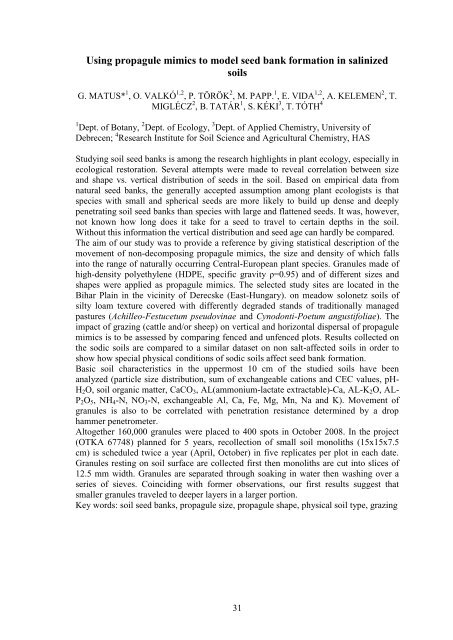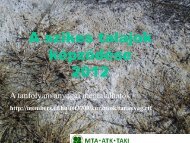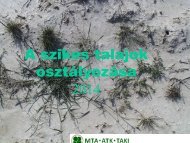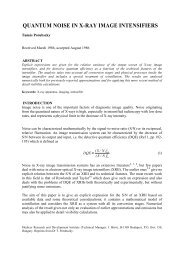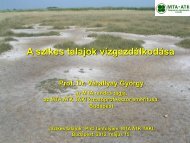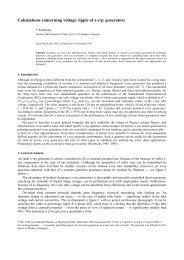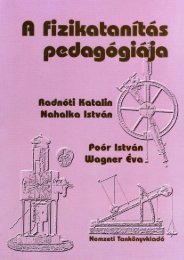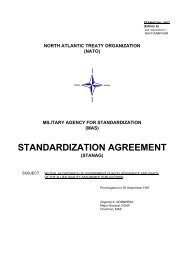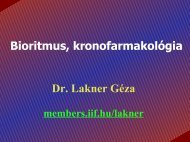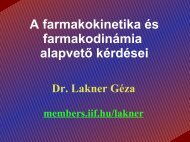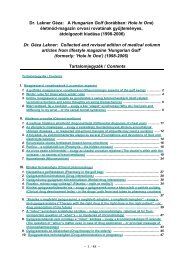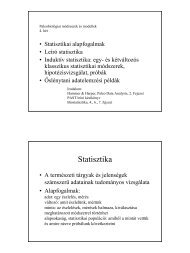Abstract form
Abstract form
Abstract form
Create successful ePaper yourself
Turn your PDF publications into a flip-book with our unique Google optimized e-Paper software.
Using propagule mimics to model seed bank <strong>form</strong>ation in salinized<br />
soils<br />
G. MATUS* 1 , O. VALKÓ 1,2 , P. TÖRÖK 2 , M. PAPP. 1 , E. VIDA 1,2 , A. KELEMEN 2 , T.<br />
MIGLÉCZ 2 , B. TATÁR 1 , S. KÉKI 3 , T. TÓTH 4<br />
1 Dept. of Botany, 2 Dept. of Ecology, 3 Dept. of Applied Chemistry, University of<br />
Debrecen; 4 Research Institute for Soil Science and Agricultural Chemistry, HAS<br />
Studying soil seed banks is among the research highlights in plant ecology, especially in<br />
ecological restoration. Several attempts were made to reveal correlation between size<br />
and shape vs. vertical distribution of seeds in the soil. Based on empirical data from<br />
natural seed banks, the generally accepted assumption among plant ecologists is that<br />
species with small and spherical seeds are more likely to build up dense and deeply<br />
penetrating soil seed banks than species with large and flattened seeds. It was, however,<br />
not known how long does it take for a seed to travel to certain depths in the soil.<br />
Without this in<strong>form</strong>ation the vertical distribution and seed age can hardly be compared.<br />
The aim of our study was to provide a reference by giving statistical description of the<br />
movement of non-decomposing propagule mimics, the size and density of which falls<br />
into the range of naturally occurring Central-European plant species. Granules made of<br />
high-density polyethylene (HDPE, specific gravity ρ=0.95) and of different sizes and<br />
shapes were applied as propagule mimics. The selected study sites are located in the<br />
Bihar Plain in the vicinity of Derecske (East-Hungary). on meadow solonetz soils of<br />
silty loam texture covered with differently degraded stands of traditionally managed<br />
pastures (Achilleo-Festucetum pseudovinae and Cynodonti-Poetum angustifoliae). The<br />
impact of grazing (cattle and/or sheep) on vertical and horizontal dispersal of propagule<br />
mimics is to be assessed by comparing fenced and unfenced plots. Results collected on<br />
the sodic soils are compared to a similar dataset on non salt-affected soils in order to<br />
show how special physical conditions of sodic soils affect seed bank <strong>form</strong>ation.<br />
Basic soil characteristics in the uppermost 10 cm of the studied soils have been<br />
analyzed (particle size distribution, sum of exchangeable cations and CEC values, pH-<br />
H 2 O, soil organic matter, CaCO 3 , AL(ammonium-lactate extractable)-Ca, AL-K 2 O, AL-<br />
P 2 O 5 , NH 4 -N, NO 3 -N, exchangeable Al, Ca, Fe, Mg, Mn, Na and K). Movement of<br />
granules is also to be correlated with penetration resistance determined by a drop<br />
hammer penetrometer.<br />
Altogether 160,000 granules were placed to 400 spots in October 2008. In the project<br />
(OTKA 67748) planned for 5 years, recollection of small soil monoliths (15x15x7.5<br />
cm) is scheduled twice a year (April, October) in five replicates per plot in each date.<br />
Granules resting on soil surface are collected first then monoliths are cut into slices of<br />
12.5 mm width. Granules are separated through soaking in water then washing over a<br />
series of sieves. Coinciding with <strong>form</strong>er observations, our first results suggest that<br />
smaller granules traveled to deeper layers in a larger portion.<br />
Key words: soil seed banks, propagule size, propagule shape, physical soil type, grazing<br />
31


